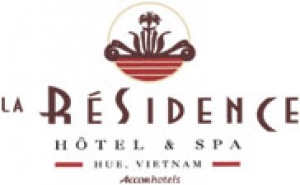La Residence in Hue Explores City’s Residential Life

Though much in Vietnam is made of the home-stay in remote hilltribe villages, the usual tourist haunts afford few opportunities to observe traditional life in the country’s towns and cities.
That’s about to change as La Residence Hotel & Spa opens the door on a new program that introduces guests to residential life in two traditional Vietnamese garden homes, known as nha ruong, and two French villas built by the city’s former colonial inhabitants.
Between April 1 and August 1, La Residence is ushering select guests on a one-of-kind of exploration of the city’s residential life. The Residential Life package includes two nights in a superior room, visits to a pair of traditional Vietnamese homes, visits to two French homes built during the colonial era, cyclo transport and a dinner at Le Parfum, the city’s premier fine-dining venue.
Descendants of Vietnamese royalty inhabit each of the garden homes on this novel itinerary. Likewise, one of the French homes on the program was built for the father-in-law of Emperor Khai Dinh. The second French home is today an art gallery and was from 1992 to 2002, the private residence of one of Hue’s formost sculptors, Diem Phung Thi.
“All too often, visitors to far-flung destinations focus on monuments, temples, palaces or parks and miss the chance to experience the spaces that anchor the Vietnamese lifestyle,” said Anthony Gill, general manager of La Residence, which itself was part of the former colonial governor’s residence. “To move among the exquisite furnishings in the French home on our itinerary, and sitting down to a meal at a traditional house in Hue’s garden district, is to access a level of intimacy with a place that’s normally not open to travellers.”
ADVERTISEMENT
The package also includes dinner at Tha Om, one of the city’s most exquisite compounds of traditional Vietnamese homes. The owner, Pham Ba Vinh, is a noted preservationist and antiques dealer who saved four traditional garden homes from the wrecking ball and reassembled them around a courtyard bounded on one side by a half-moon lotus pond.
“This place is right out of your dreams of East Asia,” said Gill. “It’s what travellers hope to experience when they travel here but rarely, too.”
Likewise the home of Phan Thuan An was built as a garden home for his wife’s grandmother, who was herself the daughter of Emperor Dong Khanh. This home is noteworthy both for its architecture, its feng shui and its collection of altars, pedestals, hutches and divans collected by generations of the same family.
Within the imperial citadel, the first French home on the itinerary was built as a private residence for the father-in-law of Emperor Khai Dinh and has remained in the family since. Residential Life travellers will dine on a box lunch prepared by the hotel in this home’s garden.

